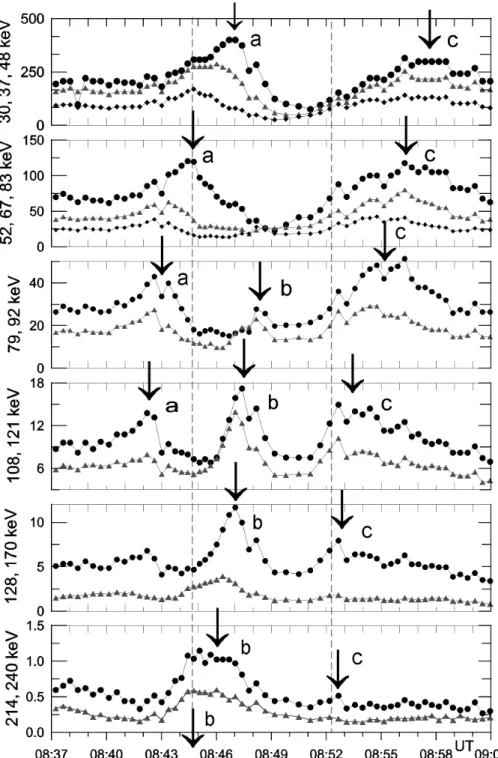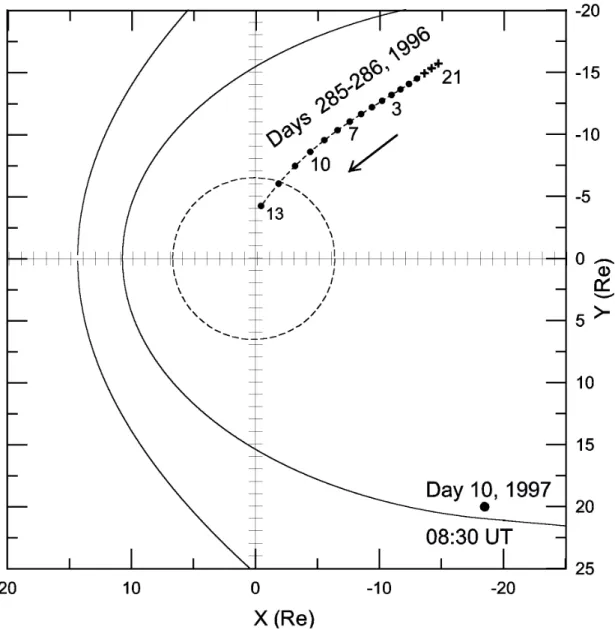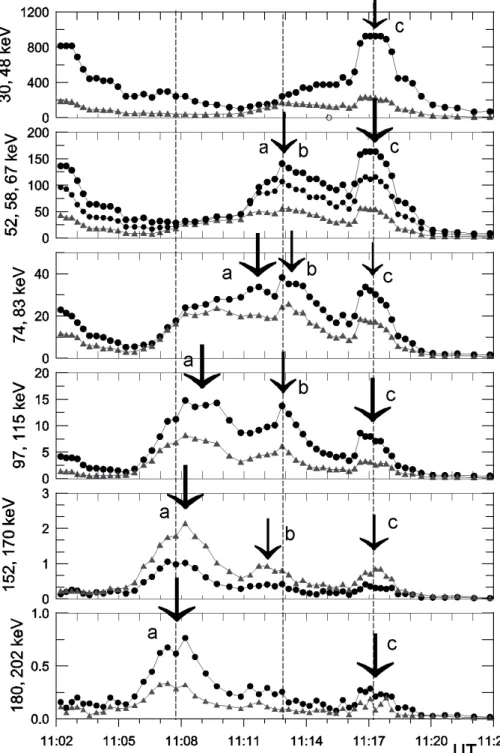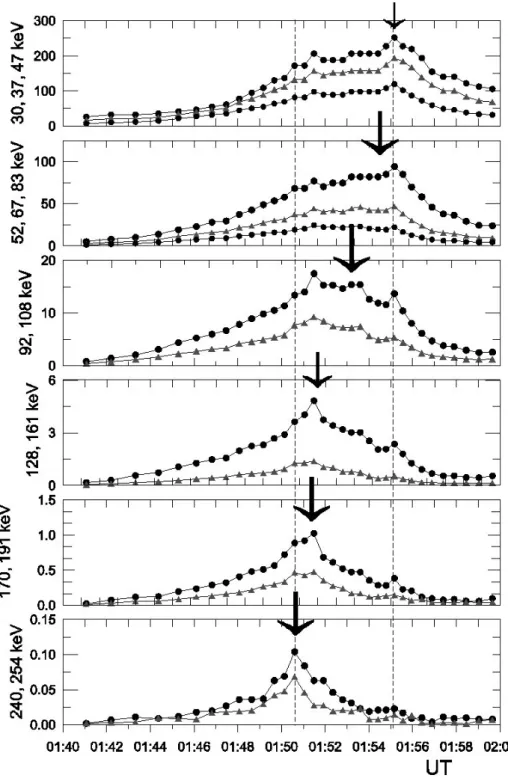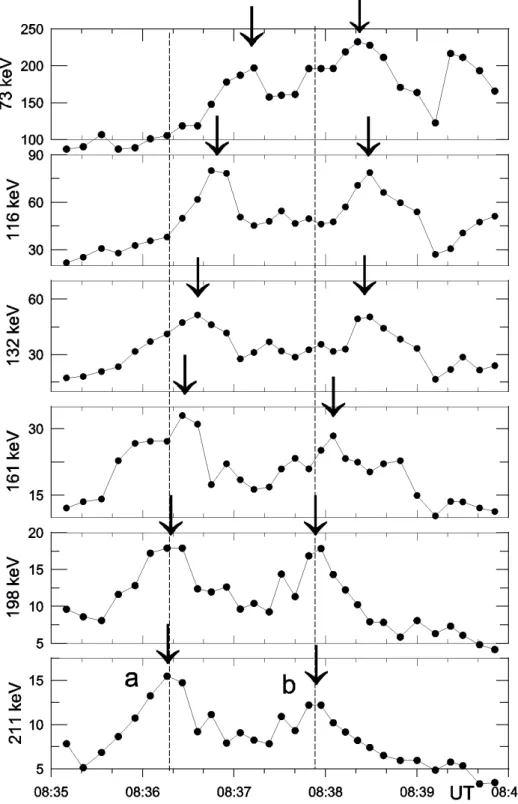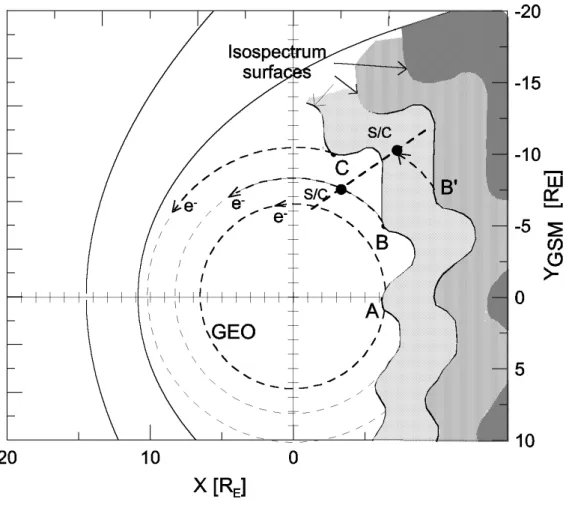HAL Id: hal-00317235
https://hal.archives-ouvertes.fr/hal-00317235
Submitted on 1 Jan 2004
HAL is a multi-disciplinary open access
archive for the deposit and dissemination of
sci-entific research documents, whether they are
pub-lished or not. The documents may come from
teaching and research institutions in France or
abroad, or from public or private research centers.
L’archive ouverte pluridisciplinaire HAL, est
destinée au dépôt et à la diffusion de documents
scientifiques de niveau recherche, publiés ou non,
émanant des établissements d’enseignement et de
recherche français ou étrangers, des laboratoires
publics ou privés.
Evidence for energetic electron and iondispersive
microinjections in theEarth’s magnetotail as far as 27
RE
D. V. Sarafopoulos, E. T. Sarris, V. Lutsenko
To cite this version:
D. V. Sarafopoulos, E. T. Sarris, V. Lutsenko. Evidence for energetic electron and iondispersive
microinjections in theEarth’s magnetotail as far as 27 RE. Annales Geophysicae, European Geosciences
Union, 2004, 22 (2), pp.527-535. �hal-00317235�
Annales Geophysicae (2004) 22: 527–535 © European Geosciences Union 2004
Annales
Geophysicae
Evidence for energetic electron and ion dispersive microinjections in
the Earth’s magnetotail as far as 27 R
E
D. V. Sarafopoulos1, E. T. Sarris1, and V. Lutsenko2
1Department of Electrical and Computer Engineering, Demokritos University of Thrace, Xanthi, Greece 2Space Research Institute, Russian Academy of Science, Moscow, Russia
Received: 9 December 2002 – Revised: 8 July 2003 – Accepted: 22 July 2003 – Published: 1 January 2004
Abstract. High energy and time resolution measurements of
energetic electron and ion fluxes obtained by the DOK-2 ex-periment on board the Interball-tail satellite provide us the opportunity to study the short-lived (1–3 min), localized, and often periodic and dispersive flux increases within the plasma sheet. We have deliberately selected and studied two inter-vals corresponding to the dawn and dusk magnetotail flanks. Dispersive electron (ion) bursts in the dawn side (dusk side) are observed from L=7 to L=27. These bursts, having an in-dividual entity, are termed microinjections and are observed in radial distances greater than those predicted by the “injec-tion boundary model.” In this paper we suggest that the dis-persive fluxes at widely separated radial distances are pro-duced by multiple pulsating isospectrum surfaces ordered in succession. At the inner edge of the plasma sheet, the isospectrum surface is considered by Sarafopoulos (2002) as a meandering injection boundary. Roughly, we estimate that the wavelength for an oscillating isospectrum surface is
∼7RE. A newly-injected population can coexist with the
population from another injection center. These electron-ion drifts probably lead to the formatelectron-ion of the profound dawn-dusk species dependent asymmetry of energetic par-ticles within the plasma sheet.
Key words. Magnetospheric physics (plasma sheet;
ener-getic particles, precipitating; MHD waves and instabilities)
1 Introduction
Quasi-periodic dispersive flux increases of energetic elec-trons with 4-min periods are identified in the morning sec-tor of the inner plasma sheet by Sarafopoulos (2002), and are termed “microinjections” because they exhibit dispersive signatures like the classical substorm-associated injections. Sarafopoulos (2002) introduced the pulsating isospectrum surface as a meandering injection boundary near the Earth, and suggested that the dispersive fluxes are due to this
sur-Correspondence to: D. V. Sarafopoulos
(sarafo@ee.duth.gr)
face. In this paper we observe the same mode of repeti-tive particle microinjections to extend radially from ∼ 7 to 27RE. These identified rhythmic particle drifts probably
pro-duce the energetic particle dawn-dusk asymmetry within the plasma sheet (Krimigis and Sarris, 1980; Sarafopoulos et al., 2001). Bursts with dispersive or dispersionless signatures seem to succeed one another and often in a periodic fash-ion. Each short-lived 1–3 min distinct burst seems to have its own individuality: Particles at once leave a space-limited region or a surface boundary and follow their own energy dependent trajectories. These “microinjections” may orig-inate from widely separated “injection centers.” At a given moment, distinct populations from different injection centers can coexist. We estimate in this case that a typical microin-jection region has a size of less than 7RE. We introduce the
geometry of multiple pulsating isospectrum surfaces ordered in succession. This layered structure of plasma sheet may suffice to produce the repetitive dispersive fluxes observed at widely separated radial distances.
2 Observations
The Interball-tail probe was launched in a highly eccentric elliptical orbit with 62.8◦ inclination and ∼31RE apogee.
The energetic particle measurements in this work were ob-tained from the DOK-2 instrument on board the Interball-tail spacecraft (Lutsenko et al., 1998) and specifically, from the detector pair that is constantly looking toward the antisolar direction. This fixed detector has full aperture angles 27◦
and 12.7◦ for electrons and ions, respectively, and can
pro-vide spectra composed of 56–57 energy channels. The accu-mulation time interval for each spectrum is variable from 1 to 1464 s, depending on the particles’ intensity that is suffi-cient to provide a given statistical accuracy. The accumula-tion time can differ for the ion and electron detectors. The ion (electron) spectra range extends from ∼27 to 821 keV (∼27 to 426 keV). Therefore, we have a great opportunity to search for dispersive bursts that flow earthward in the plasma sheet.
528 D. V. Sarafopoulos et al.: Energetic electron and ion dispersive microinjections
Fig. 1. From top panel downward differential electron fluxes for progressively higher energy channels are shown. The injected electrons in
each of the three flux increases are seen first at higher energies.
2.1 Dawn side electron dispersive microinjections
We display, from top to bottom in Fig. 1, electron differential fluxes at progressively higher energy channels. Three dis-tinct, successive, short-lived and dispersive electron flux in-creases seem to originate from different “microinjection cen-ters” and drift dawnward. At 08:46 UT populations from the flux increase marked as “a” and “b” and coexist. The lifetime for each structure may be longer than the individual burst
du-ration. The initial activations and subsequent microinjections take place westward of the spacecraft. Each burst does not cover the same energy range, although it is observed at the same site (X, Y, Z)GSM=(−5.7, −9.7, −2)RE, at L=11.4.
The satellite position is shown in Fig. 2, which shows the projected Interball trajectory over the XYGSM plane from
21:00 UT of Day 285 to 13:00 UT of Day 286, 1996. During this period, Interball moved from (X, Y, Z)GSM =
D. V. Sarafopoulos et al.: Energetic electron and ion dispersive microinjections 529
Fig. 2. Interball trajectory projected on the XYGSMplane and corresponding to the interval from 21:00 UT of Day 285 to 13:00 UT of Day 286, 1996, and Interball position at 08:30 UT of Day 10, 1997. Trajectory is divided by one symbol per hour. Average bow shock and magnetopause positions, as well as the GEO orbit (dashed line), are shown.
dusk side plasma sheet, and one symbol per hour is used along the trajectory.
Another event closer to the Earth, at L=7.5, is shown in Fig. 3 that provides strong evidence that an old population can co-exist with a newly-injected one. The first injected population at 11:07 UT (burst “a” along the 202 keV electron flux trace, bottom panel), drifts dawnward and mixes with that from another microinjection activated after ∼10 min. The latter flux increase “c” is locally energized at 11:17 UT and displays dispersionless character. Thus, it seems that two distinct and successive injection centers a few RE apart are
probed. A minor flux increase between the “a” and “c” fluxes is also observed. Therefore, in this event, as well as in that of Fig. 1, a repetition cycle of 5 min is apparent. Moreover, between these two events, two additional periodic events are shown in the past by Sarafopoulos (2002), which display in
all 13 dispersive flux increases a ∼4 min periodicity. During the same day, closer than L=7.5 periodic (although disper-sionless) flux increases are also detected (not shown here). Importantly, we detect dispersive bursts even earlier during this day. Figure 4 shows a dispersive electron flux corre-sponding to L=18. The major peak flux is first seen at the bottom panel for the highest energy electron channel and progressively, it is shifted to gradually lower energies (up-ward panels). This dawn(up-ward drift may accumulate negative energetic population to the dawn side plasma sheet. More-over, the major peak flux of ∼250 keV (bottom panel) occurs with a weak flux increase of ∼30 keV (top panel). In paral-lel with the dispersive feature, a dispersionless population is also present and is probably due to the source extent along the Y -axis. A similar episode to that of Fig. 4 was observed at ∼21:40 UT of Day 285 and L=21 (not shown here).
530 D. V. Sarafopoulos et al.: Energetic electron and ion dispersive microinjections
Fig. 3. Similar format as in Fig. 1. The flux c shows a dispersionless character.
2.2 Dusk side ion dispersion signatures
We observe dispersive ion flux increases (instead of electron) in the dusk sector plasma sheet. Two ion dispersive flux in-creases observed on 10 January 1997, are shown in Fig. 5. They occurred when Interball was located at (X, Y, Z)GSM∼=
(−18.5, 20.3, 1)RE, at L=27.4. Nevertheless, in contrast to
the large radial distance, the drift mechanism seems to work, accumulating energetic ions to the dusk side plasma sheet. The more energetic ions drift faster and are seen prior than
the lower energy particles. In Fig. 5 the dispersive structures are marked with arrows and their duration is ∼1 min. The ion fluxes occur at the central plasma sheet, when the local magnetic field Bx is less than 5 nT (not shown here), and
the local lobe magnetic field level is ∼30 nT. No abrupt Bx
transition accompanies the fluxes. Therefore, we believe that these dispersive signatures are probably due to westward ion drifts (and not due to a velocity selection effect at the plasma sheet boundary layer).
D. V. Sarafopoulos et al.: Energetic electron and ion dispersive microinjections 531
Fig. 4. Similar format as in Fig. 1. Dispersive electron flux increase observed at L=21.
3 Discussion
3.1 Isospectrum surfaces ordered in succession
In the original formulated models of classical injections, McIlwain (1974) postulated the existence of a sharp bound-ary located near the geosynchronous orbit (GEO), behind which an energization mechanism causes the rapid accumu-lation of hot plasma. At the injection time, particles of all
energies leave the regions at and behind the boundary, and follow drift orbits. Sarafopoulos (2002) considered that “the injection boundary,” at times, forms meanderings. Be-hind this wavy surface, the region is assumed to be replete with higher fluxes of energetic particles (shaded region in his Fig. 4). This surface was termed an isospectrum surface and, like the injection boundary (see Mauk and Meng, 1983), was assumed that (a) it is the same for particles of all energies, and that (b) it spirals outward across contours of constant
532 D. V. Sarafopoulos et al.: Energetic electron and ion dispersive microinjections
Fig. 5. Similar format as in Fig. 1, but for two ion dispersive flux increases.
magnetic field magnitude, as well as across contours of con-stant radial distances. In this work we have presented dis-persive electron fluxes from L=7 to 21 in the dawn side, and dispersive ion fluxes at L=27 in dusk side. It seems that suc-cessive isospectrum surfaces are formed in the whole near-Earth plasma sheet. In Fig. 6, we indicatively show three successive isospectrum surfaces with an outward gradient of
energetic particles. Energetic electrons that leave regions A, B, and C of the innermost surface and follow the three drift trajectories shown with thick-dashed and circular lines, create dispersive fluxes at different radial distances. Impor-tantly, energetic electrons leaving the protrusions B or B0that correspond to different isospectrum surfaces will create dis-persive fluxes at different spacecraft (S/C) positions marked
D. V. Sarafopoulos et al.: Energetic electron and ion dispersive microinjections 533
Fig. 6. Schematic showing three successive and meandering isospectrum surfaces. The darkest area corresponds to the densest populated
region. The injected electrons from the earthward protrusions A, B, C and B0produce dispersive fluxes at increasing radial distances. The bow shock and magnetopause surfaces (solid lines), the GEO (thick- dashed line) orbit and the satellite (S/C) trajectory are shown.
with solid dots. The energy dependent eastward drift pro-duces the recurrent dispersive electron bursts at Interball. If the satellite were positioned at B, then dispersionless pulsa-tions would be anticipated, like the burst “c” in Fig. 3. There-fore, pulsating isospectrum surfaces ordered in succession may suffice to produce the rhythmic character of detected dispersive fluxes at widely separated radial distances.
3.2 Wavelength for a pulsating isospectrum surface
At ∼11:08 UT of Day 286, 1996, the burst “a” along the 202 keV electron flux trace (Fig. 3, bottom panel) is observed
∼5 min earlier than the 52 keV electron flux increase (Fig. 3, second panel). If we take into account the spacecraft radial distance L=7.7, the magnetopause standoff distance to be 10RE, and the drift periods for the two above mentioned
en-ergy channels, then a rough estimate concerning the injection site, for the burst “a,” will locate it ∼3.5REwestward of the
spacecraft. Additionally, if the spacecraft is assumed equally distanced from the two successive plasma sheet earthward protrusions (Regions B and C in Fig. 6), then the oscillating isospectrum surface will have a ∼7REwavelength.
3.3 Dawn-dusk asymmetry of energetic particles
The mechanism producing the dawn-dusk asymmetry of en-ergetic particles, which was recently studied by Sarafopou-los et al. (2001) and earlier by Krimigis and Sarris (1980), is directly observable in this work through distinct examples demonstrating electron dawnward and ion duskward drifts at large radial distances in the nightside magnetosphere. The repetitive and dispersive (or dispersionless) flux increases in this work, as well as the periodic events presented by Sarafopoulos (2002), are probably associated with Pc5 stand-ing waves commonly observed over the plasma sheet bound-ary layer (Sarafopoulos and Sarris, 1991), or the wavy mod-ulated lobe magnetic field structure (Sarafopoulos, 1995), or the low-latitude boundary layer waves (Sarafopoulos, 1993). We speculate that the whole near-Earth magnetosphere of-ten vibrates in the Pc5 mode, and consequently, successive isospectrum surfaces are developed, which on the earthward edge of the plasma sheet forms a pulsating injection bound-ary. The latter may be a fundamental element in a pro-cess leading to the growth of an instability that eventually triggers a substorm. A pulsating injection boundary proba-bly produces the nine-peaked proton fluxes accompanying a
534 D. V. Sarafopoulos et al.: Energetic electron and ion dispersive microinjections substorm-associated injection in the case studied by Belian
et al. (1984).
3.4 Dispersive fluxes and the “Injection boundary model”
From 21:00 UT of Day 285 to 12:00 UT of Day 286, 1996, the Kpindex successively takes the values 2-, 2, 3+, 2+, and
3. Mauk and McIlwain (1974) have formulated the injec-tion boundary as a funcinjec-tion of Kp. They obtained the
re-sult Rb=(122 − 10 Kp)/(LT–7.3), where Rbis the injection
boundary radius in REat a given local time (LT) for a given
Kp. This equation traces a spiral and is only valid for the
pre-midnight region to ∼01:00 LT (which should be expressed as 25 LT in the above equation). This surface was assumed as a stationary boundary, tailward of which all electrons and protons are energized together at the same time (Mauk and Meng, 1983; Lopez et al., 1990), producing dispersionless signatures. Certainly, in this work we do not present sub-storm associated injections; instead we show short-lived persive flux increases that they occur, at times, at radial dis-tances larger than those that the above model predicts. In any case, dispersive fluxes behind the injection boundary re-main unexplained by this stationary model. Dispersionless substorm onsets frequently occur around midnight at local times (see the statistics performed by Friedel et al., 1996), which seems to indicate that the satellite must be very near or within the acceleration source region, in order to see dif-ferent energy particles before they drift apart.
3.5 Dispersive fluxes and BBFs.
Throughout the interval 09:55–11:25 UT of Day 286, 1996, quasi-periodic and dispersive energetic electron flux in-creases are shown in Figs. 1 and 3, and in the past by Sarafopoulos (2002). This interval is discussed below in the context of Bursty Bulk Flow events (BBFs). We use the CORAL plasma experiment with 2-min resolution of plasma moments due to a 2-min spin of Interball. The conclusion is that our dispersive fluxes are not associated with BBFs. BBFs are fast flow plasma samples concentrated in 10-min timescale intervals of plasma sheet flow enhancements (An-gelopoulos et al., 1994 and references therein). Angelopou-los et al. (1994) are defined BBFs as continuous ion flow events with magnitude above 100 km/s, while during the BBF event low flow (Vi< 100 km/s) samples do not inter-vene. In contrast, our dispersive flux increases occur with plasma velocity almost continuously lower than the level of 100 km/s, or the velocity slightly exceeds this level for one or two samples. Additionally, they observed that earthward BBFs are more frequently close to midnight and away from Earth, up to a distance of ∼19RE, whereas our observations
occur at YGSM > −5 RE and near the Earth. Another
sig-nificant element is that the studied dispersive fluxes occur with very low geomagnetic activity (see Fig. 5 in paper by Sarafopoulos, 2002), whereas the BBFs are positively corre-lated with the AE index.
4 Conclusions
Duskward (dawnward) ion (electron) drifts were detected as far as ∼27RE(21RE)from the Earth. Therefore, the
propa-gation paths of energetic particles, which probably produce the energetic particle dawn-dusk asymmetry (see Sarafopou-los et al., 2001), are better understood. Although injections are commonly observed at 6.6RE, the exhibited
“microin-jections,” in other words, the short-lived and dispersive flux increases, are seen up to L=27. We introduce the geometry of successive and pulsating isospectrum surfaces in the near-Earth plasma sheet, which probably produce the detected dis-persive fluxes. We estimate that the oscillating isospectrum surface roughly has a wavelength of ∼7RE.
Acknowledgements. We thank Yu. Yermolaev and A. Fedorov for the provision of the CORAL plasma moments, and N. Sidiropoulos for his help preparing the initial data time series.
Topical Editor T. Pulkkinen thanks a referee for his help in eval-uating this paper.
References
Angelopoulos, V., Kennel, C. F., Coronity, F. V., Pellat, R., Kivel-son, M. G., Walker, R. J., Russell, C. T., Baumjohann, W., Feld-man, W. C., and Gosling, J. T.: Statistical characteristics of bursty bulk flow events, J. Geophys. Res., 99, 21 257–21 280, 1994.
Belian, R. D., Baker, D. N., Hones, E. W., and Higbie, P. R.: High-energy proton drift echoes: Multiple peak structure, J. Geophys. Res., 89, 9101–9106, 1984.
Friedel, R. H., Korth, A., and Kremser, G.: Substorm onsets ob-served by CRRES: Determination of energetic particle source regions, J. Geophys. Res., 101, 13 137–13 154, 1996.
Krimigis, S. M. and Sarris, E. T.: Energetic particle bursts in the Earth’s magnetotail, in: Dynamics of the Magnetosphere, edited by Akasofu, S.I., Reidel Publishing Co., 599–630, 1980. Lopez, R. E., Sibeck, D. G., McEntire, R. W., and Krimigis, S. M.:
The energetic ion substorm injection boundary, J. Geophys. Res., 95, 109–117, 1990.
Lutsenko, V. N., Kudela, K., and Sarris, E. T.: The DOK-2 exper-iment to study energetic particles by the Tail probe and Auroral probe satellites in the INTERBALL project, Cosmic Res., 36, N1 (Translated from Kosmicheskie issledovaniya), 94–103, 1998. McIlwain, C. E.: Substorm injection boundaries, in:
Magneto-spheric Physics, edited by McCormac, B. M., D. Reidel Pub. Co., Dordrecht-Holland, 143, 1974.
Mauk, B. H. and McIlwain, C. E.: Correlation of Kpwith substorm-injected plasma boundary, J. Geophys. Res., 79, 3593, 1974. Mauk, B. H. and Meng, C.-I.: Dynamical injections as the source
of near geostationary quiet time particle spatial boundaries, J. Geophys. Res., 88, 10 011–10 024, 1983.
Sarafopoulos, D. V. and Sarris, E. T.: Long-period standing waves at the plasma sheet boundary layer region observed by ISEE-1, Ann. Geophysicae., 9, 333–347, 1991.
Sarafopoulos, D. V.: Simultaneous observation of Pc 5 pulsation in the dawn and dusk low-latitude boundary layer, Ann. Geophysi-cae., 11, 990–1010, 1993.
D. V. Sarafopoulos et al.: Energetic electron and ion dispersive microinjections 535
Sarafopoulos, D. V., Long duration Pc 5 compressional pulsations inside the Earth’s magnetotail lobes, Ann. Geophysicae., 13, 926-937, 1995.
Sarafopoulos, D. V., Sidiropoulos, N. F., Sarris, E. T., Lutsenko, V., and Kudela, K.: The dawn-dusk plasma sheet asymmetry
of energetic particles: An INTERBALL perspective, J. Geophys. Res., 106, 13 053–13 065, 2001.
Sarafopoulos, D. V.: Dispersive and repetitive Pc 5 mode microin-jections in the inner magnetosphere, Geophys. Res. Lett., 29(8), 1185, doi:10.1029/2001GL014067, 2002.
